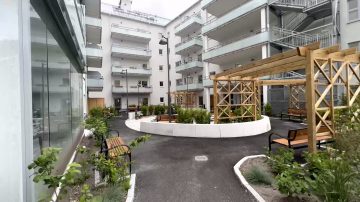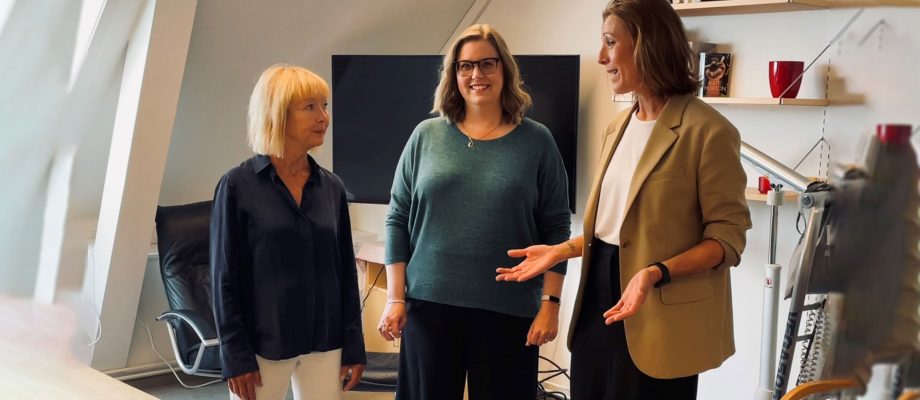INTER-ACTION. A recent letter of intent signed between the University of Gothenburg and the City of Gothenburg opens up greater opportunities to work together on skills supply, education and research. The common aim is to be better equipped to meet the challenges of the future, including those of an ageing population and a shrinking workforce.
Babbs Edberg, Director of the Elderly and health and social care administration at the City of Gothenburg says:
“What we have put in place now is very much broader than our previous collaboration, which was more to do with students and work placements than it was about research and development. The letter of intent made it much clearer that we can join forces.”
Helle Wijk, Assistant Head of Department at the Institute of Health and Care Sciences at the University of Gothenburg says that work has been underway for many years to ensure that the same conditions apply to work-based education placements (VFU) in the city and in the region.

“The letter of intent signed between the City, Chalmers and GU in 2020 enabled us to set up a lot of activities. Welfare is one area where we have teamed up, focusing on the elderly,” she says.
Focus on the needs of the City of Gothenburg
Ramona Schenell, head of development in research and development at the city’s Elderly and health and social care administration, says that the question of what the university and the city need to collaborate on has become increasingly central:
“The students are one aspect; what do they need to learn if they are going to work in city-run health and social care? But another extremely important question is what the city’s needs will be. Now we can be involved and have a say in the training that will be required,” says Ramona.

“In the past we could probably have been better at saying what we need in the city, but we are on the same page now and that’s a big step forward,” says Babbs Edberg. “Of course the major challenge comes from demographic trends. What will welfare look like when it’s unlikely we’ll have the workforce we’ll need? We need to help each other find solutions. If we are to cope with the challenges as a society, collaboration between research and services on the ground is vitally important, as is everything that happens in these interfaces.”
Transition demands research and training
The Local healthcare reform, as it is known, will see the majority of healthcare being brought closer to users as primary and municipal healthcare. The Government inquiry on the transition to local healthcare found that the municipalities need to invest in research.
“The healthcare reform is what matters right now,” says Helle Wijk:
“We need the skills! No-one knows how this transition will work but we need to find out; we have key roles to play here. We want staff to have the skills and a desire to work in local healthcare. Getting there will be easier if we work together.”
“We mustn’t just sit there in our separate silos. City employees teaching on our nursing programme and researchers spending time out in the services themselves will see us make progress. This is a really important exchange,” says Ramona Schenell, who is also an adjunct lecturer in The Life Context and Health Promotion at the Institute of Health and Care Sciences.
Ramona continues:

“At the moment, there are two of us researchers employed in the Elderly and health and social care administration who have links to the Institute of Health and Care Sciences with the aim of building up a research infrastructure here.”
Ramona and her colleague were also tasked with finding out how to start a knowledge centre for the City of Gothenburg which encompasses research, development and collaboration.
“When I heard about it, I instantly thought we need to do this!” Babbs Edberg exclaims:
“We are currently reviewing the structures to see how we can work and support services with tools for development. And we can’t do that on our own. We are delighted that there is interest and curiosity from the university’s side.”
Doctoral students driving change
Ramona Schenell describes a successful example of research in a local government context:
“At the moment we have a district nurse in the administration who is spending half her time as a doctoral student researching hard-to-heal wounds. Sufferers are in a lot of pain and here the district nurse identified an opportunity to improve quality in a project that directly benefits patients and improves staff expertise. We are pleased with this model in which the doctoral student can remain employed by us and conduct research at the same time. It means that the knowledge benefits the city directly and it’s so positive to find employees who are willing to drive progress.”
Ramona continues:
“We want to build structures for this and put in place a system for integrating research so it isn’t just dependent on the goodwill of individual managers. Our deeper collaboration means we will also be able to link up external research teams with us as we build the internal structure.”

Academic care homes
Another example is the academic nursing and care home Silvergruvan which was developed in partnership between the city and the university. More than a nursing and care home, it is a place that brings many people together, tenants, relatives, staff, students and researchers.
“You could call it a testbed. Research and development are carried out here which can then be transferred to other services. For example, we are already working on a project on being a contact person and in the autumn we will be looking at starting a training module for students and producing a model to easily drive improvements,” says Ramona Schenell.
“This partnership is crucial in terms of the details and the bigger picture,” says Babbs Edberg. “The residents at Silvergruvan will see this as research and development are put into practice on the ground but it is also part of the solution for the welfare of the future. Working together will make it so much easier to meet the challenges ahead!”
BY: LOVISA AIJMER











